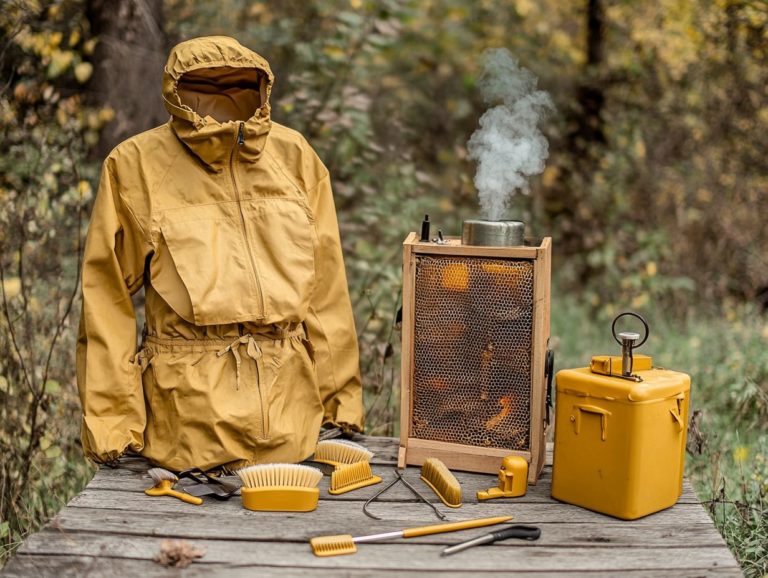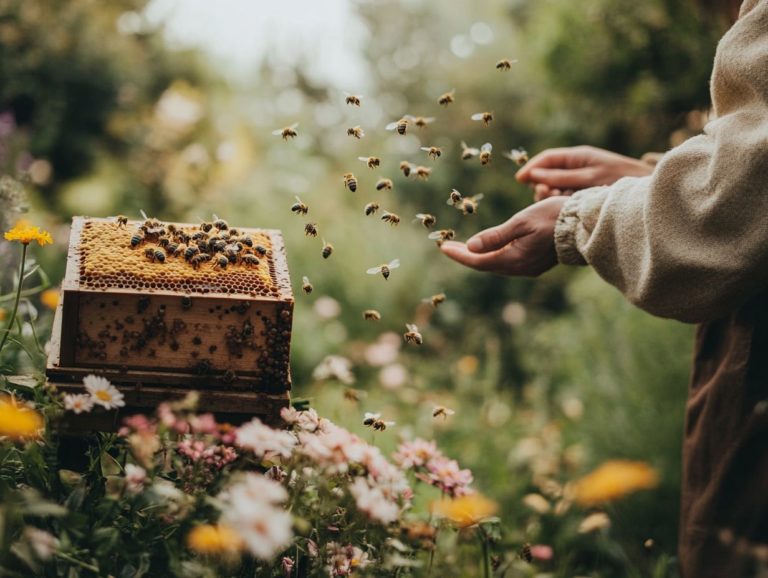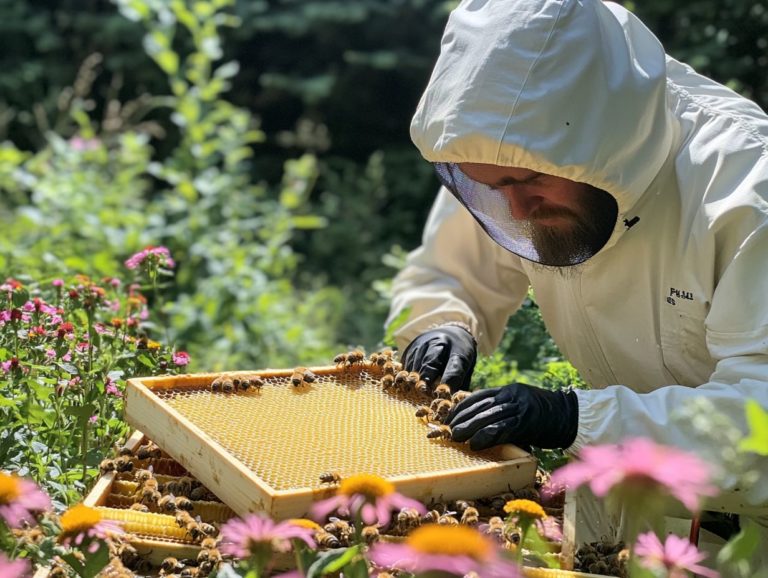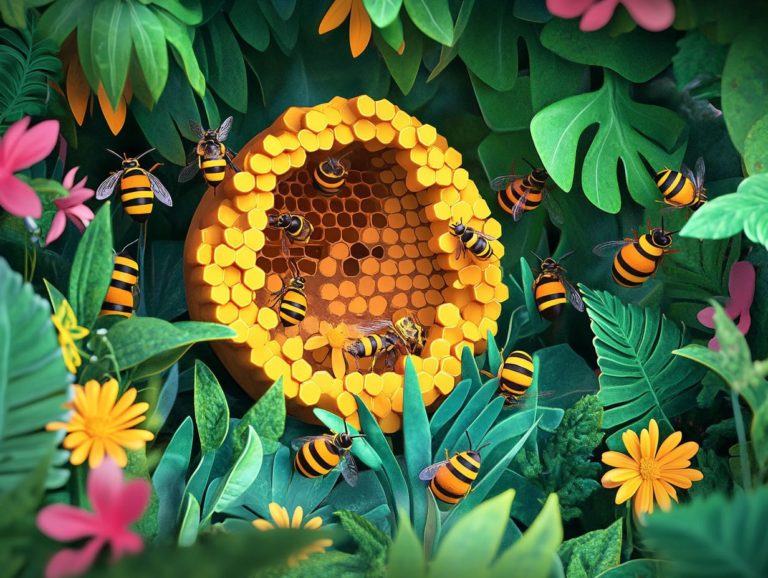How to Reduce Hive Swarming
Hive swarming is a natural yet complex behavior in bees that can significantly affect both the bee colony and your beekeeping practices, including swarm management.
To navigate this phenomenon effectively, it s essential to understand what triggers swarming, the consequences it can have, and the best strategies for prevention. This article delves into the causes of hive swarming, its impact on bee colonies, and provides practical tips for effective swarm management.
Regardless of whether you re an experienced beekeeper or just embarking on this journey, you’ll discover valuable insights to help you maintain a thriving hive.
Contents
- Key Takeaways:
- What is Hive Swarming?
- Why is Hive Swarming a Problem?
- How to Prevent Hive Swarming?
- How to Handle a Swarm?
- What to Do if a Swarm Cannot Be Prevented?
- Frequently Asked Questions
- What is hive swarming and why is it important to reduce it?
- How can I identify the signs of a potential hive swarm?
- What are some techniques to reduce hive swarming?
- Is there a specific time of year when hive swarming is more likely to occur?
- Are there any natural methods to reduce hive swarming?
- What should I do if my hive does end up swarming?
Key Takeaways:
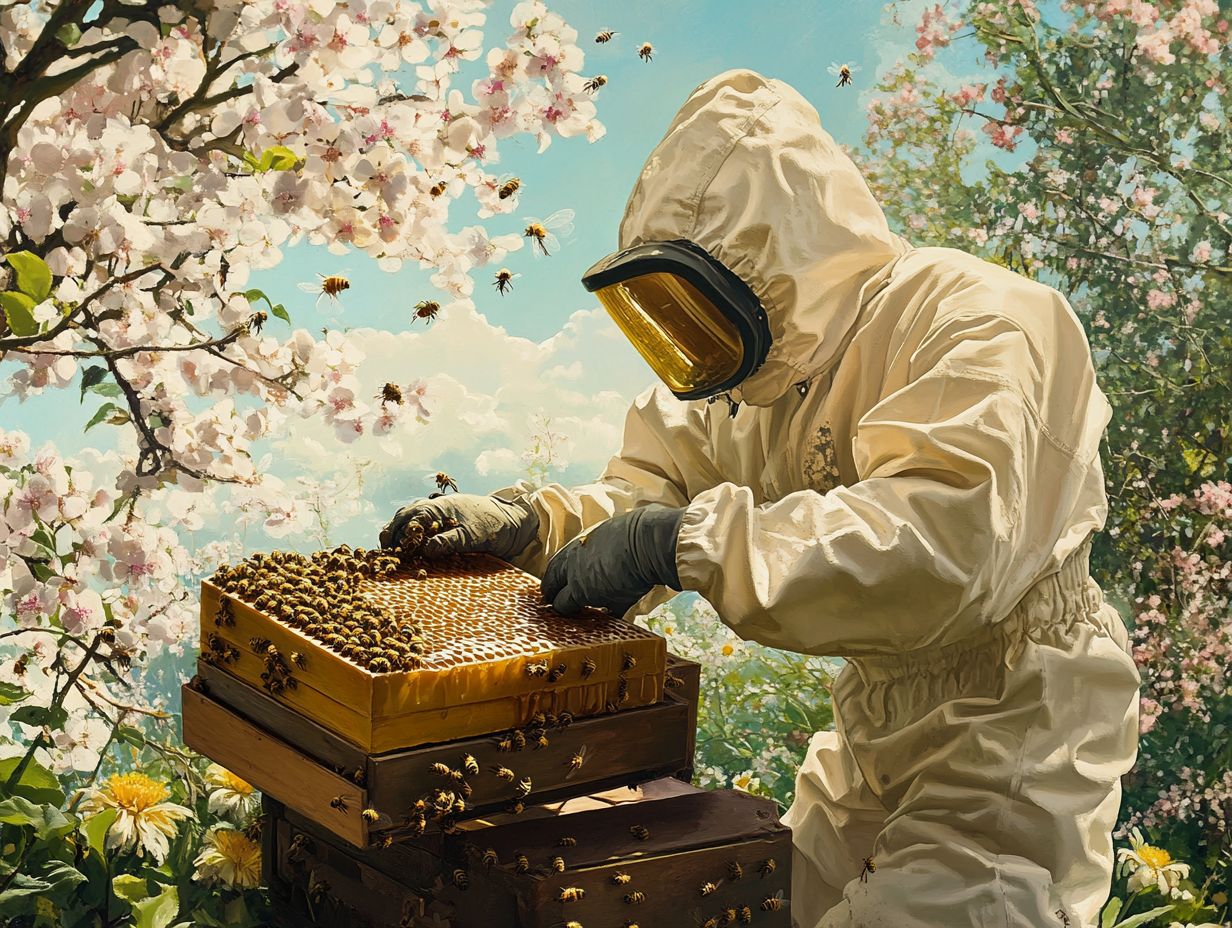
- Regularly inspecting the hive and removing queen cells can help prevent hive swarming, aiding in better population control.
- If a swarm cannot be prevented, contact a local beekeeper or find a new home for the bees to ensure their survival. Alternatively, consider using swarm traps to capture the swarm effectively.
- Providing adequate space and keeping the queen bee healthy are key in reducing hive swarming, with techniques like hive splitting and using a queen excluder.
What is Hive Swarming?
Hive swarming is a fascinating natural occurrence in beekeeping, where a bee colony splits to establish a new one. This process is often triggered by factors such as overcrowding, an abundant nectar flow, or the presence of swarm cells. It plays a vital role in the lifecycle of bees, especially in regions like New South Wales, where environmental conditions can significantly influence bee behavior and swarm management strategies. In such areas, spring management techniques become crucial to handle seasonal swarming tendencies.
By grasping the dynamics of hive swarming, you can enhance your beekeeping practices, ensuring your colonies thrive while optimizing honey production. Additionally, you ll be better equipped to manage the risks posed by Varroa mites, which can jeopardize the health of your colonies. Conducting regular brood inspections is key to identifying early signs of these issues.
What Causes Bees to Swarm?
Bees swarm mainly due to environmental pressures and the dynamics within their colony. You ll notice signs like swarm cells and congestion in the hive that indicate it s time for a split. Factors such as increased bee traffic, high population density, and a plentiful nectar flow can drive a colony to reproduce by swarming.
By understanding these triggers, you can implement effective swarm prevention strategies that help maintain your colony’s health and productivity.
Essentially, the relationship between these environmental conditions and the internal state of the colony creates the perfect storm for swarming. For example, when your colony becomes overcrowded, worker bees will start building queen cells as a precursor to raising a new queen and leaving with a portion of the hive. Moreover, fluctuating temperatures and seasonal shifts can heighten hive congestion.
Some bee species are inherently more prone to swarming behavior, with their tendencies influenced by genetic makeup and adaptability to their environment.
By recognizing these critical signs, you can manage your hives more effectively, preventing loss and ensuring a thriving bee population.
Why is Hive Swarming a Problem?
Hive swarming presents considerable challenges for beekeepers, potentially resulting in diminished honey production and impaired colony health. When a colony decides to swarm, it reduces the number of bees available for foraging and caring for the brood, while simultaneously elevating the risk of Varroa mite infestations an additional threat to the hive’s overall viability.
Grasping the implications of hive swarming is crucial for developing effective prevention and management strategies. This includes conducting regular hive and brood inspections, which are vital for sustaining healthy colonies.
How Does Hive Swarming Affect Bee Colonies?
Hive swarming can significantly impact your bee colonies. It disrupts population control and can lead to declines in colony health and productivity.
When a swarm occurs, the remaining bees may struggle with foraging and brood care. This struggle affects honey production and the colony’s overall strength.
The queen replacement process and the colony’s lifecycle might change, requiring thoughtful management strategies to address these challenges.
When part of the colony leaves, the workforce noticeably reduces. This reduction makes it hard for the remaining bees to keep up with their usual tasks.
This imbalance can lead to insufficient nursing, which is crucial for developing larvae. Ultimately, this delays the growth of the next generation.
If the new queen fails to emerge or mate successfully, honey production could suffer severely. To mitigate these risks, beekeepers can adopt several strategies:
- Regular hive inspections
- Providing ample space for brood rearing
- Utilizing swarm traps to capture and manage swarms effectively
By addressing the causes of swarming, you can help preserve the health and productivity of your bee colony.
How to Prevent Hive Swarming?
Act quickly to prevent hive swarming and protect the vitality of your bee colonies! Preventing hive swarming is crucial for the health and productivity of your colonies, especially in regions like New South Wales, where environmental factors can increase swarming tendencies.
Conduct regular hive inspections to monitor colony health. Techniques such as the Demaree method, which separates the queen from the rest of the colony, and hive splitting help manage population control.
Using swarm traps can catch swarms before they leave. Also, ensure the queen has enough room for egg-laying by monitoring the honeycomb frame.
Supering early and using a queen excluder will provide your hive with ample space and resources. This strategy reduces congestion and minimizes the likelihood of swarming.
1. Provide Adequate Space
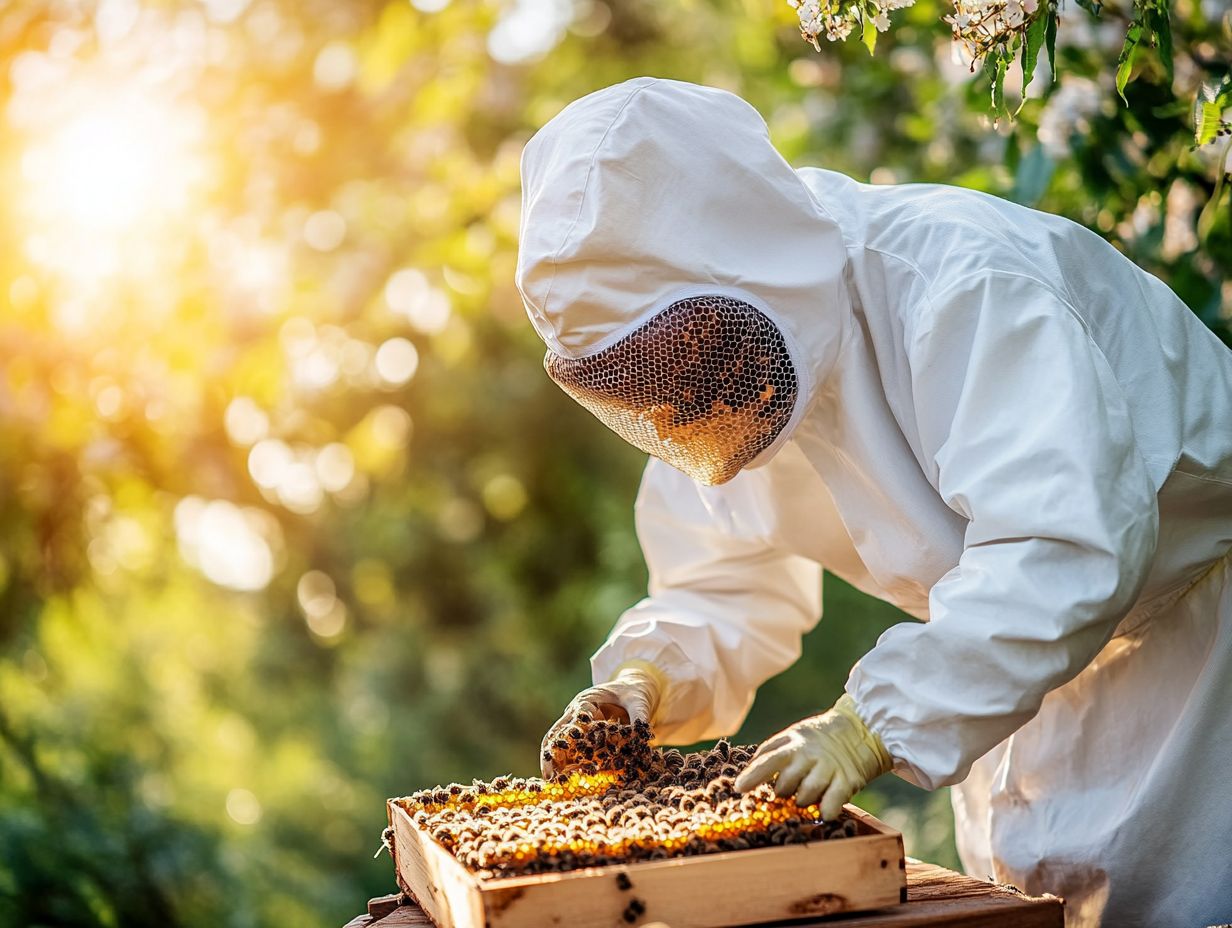
Providing ample space within the hive is crucial to prevent crowding, a condition that can prompt swarming behavior among your bees. By ensuring there s enough ventilation and room for honey reserves, brood boxes, and drawn comb, you create a healthy environment for your hive.
Regularly monitor the space in your hive, and consider adding supers (additional boxes for honey storage) or additional brood boxes as your bee population grows.
Hive space is vital for your bees success! It directly impacts the colony’s productivity and overall well-being. Proper ventilation regulates internal temperatures and humidity, protecting both the bees and the stored honey from harmful conditions.
To manage effectively, adopt strategies such as strategically placing hives to maximize airflow. This allows your bees to thrive without unnecessary stress. By evaluating honey production patterns and foraging activity, you can make timely adjustments to the space to meet the colony’s demands.
By proactively addressing these factors, you can significantly enhance the sustainability and productivity of your hives.
2. Keep Your Queen Bee Thriving!
Maintaining the health of your queen bee is crucial for preventing hive swarming. A strong queen can lead the colony well and inhibit the formation of queen cells, which are special structures where new queens can develop.
By regularly monitoring her condition and considering potential queen replacements, you can ensure the genetic health of your colony remains robust. Genetic diversity helps strengthen the hive and boosts overall productivity among your bees.
Be vigilant in assessing the queen’s well-being to preemptively address any swarming issues. Look out for signs such as reduced egg-laying rates or unusual behaviors, which may indicate that your queen is aging or under stress.
If you notice multiple queen cells, it could signal an impending swarm, prompting you to take immediate action. Implementing a schedule for routine inspections will help you identify these issues early on.
If your queen exhibits signs of poor health or if the colony s productivity begins to wane, don’t hesitate to replace her. Introducing mating drones can also enhance genetic diversity within your hive.
Ultimately, ensuring that your queen thrives will maintain a balanced hive and a robust population capable of foraging and pollinating effectively.
Take charge of your hive and ensure your queen bee is in top health to enjoy a thriving colony!
3. Regularly Inspect the Hive
Regular hive inspections are essential for you to spot early signs of swarming and maintain the overall health of your colony. By regularly checking the brood, you can observe bee behavior, assess bee population, and identify potential issues before they escalate into swarming events. Proactive hive management through consistent inspections not only helps you understand your colony’s needs better but also plays a crucial role in effective swarm prevention.
These inspections offer you a valuable opportunity to look for diseases, pests, and environmental factors that could jeopardize the wellbeing of your hive. Keep an eye out for signs of varroa mites and brood diseases like American foulbrood. Assess the condition of your queen. Regularly check food stores, especially during busy times when resource demand spikes. Understanding seasonal swarming patterns can also help in planning inspections more effectively.
By regularly evaluating these aspects, you not only bolster the resilience of your colonies but also enhance the longevity of honey production and the overall viability of your hive.
4. Remove Queen Cells
One of the effective ways to prevent swarming is by removing queen cells during regular hive inspections. By doing so, you can disrupt the colony s preparation for swarming and maintain control over the hive s population dynamics. This method, along with techniques like the Demaree method a technique used to control swarming can really help stop swarming.
Regular queen cell removal, particularly during peak swarming seasons, ensures that the colony does not reach critical conditions that trigger reproductive swarming behaviors. Keep an eye on factors like nectar flow and bee traffic within the hive, as these can also influence the swarm tendencies of your bees.
When removing queen cells, it s essential to handle the frames carefully to avoid damaging the naturally drawn comb and to maintain the integrity of the hive s structure. This careful management helps in preserving the equilibrium of the colony and ensures that your bees remain productive and healthy.
Removing queen cells during your hive inspections is a smart and proactive step to prevent swarming and keep your colony stable. By identifying and eliminating these swarm cells, you significantly reduce the chances of a swarm leaving your hive, ensuring that your current queen continues to thrive in her vital role. This practice becomes especially critical during the spring management period when swarming tendencies tend to peak.
To effectively manage this aspect of hive health, it’s essential to employ specific techniques that enhance your inspections. Regularly checking the hive frames for royal jelly-filled cells is a must, as these are clear signs of queen cell development.
Take the time to assess the brood pattern and overall hive population, since a crowded environment can lead to an increased likelihood of swarming. Implementing preventative measures, such as providing additional space or splitting the colony, can also help thwart the formation of queen cells.
By adopting these strategies, you can successfully maintain harmony within your colony while ensuring that your bees remain productive throughout the beekeeping season.
5. Use Swarm Traps
Utilizing swarm traps is a highly effective strategy in your beekeeping practice. This proactive approach allows you to capture swarms before they take flight from the hive. It helps control populations and reduce congestion, promoting overall hive health.
You ll want to strategically place these traps in areas known for high swarming tendencies, effectively managing excess bee populations. Regularly checking your swarm traps is essential to maximize their success rate.
The placement of these traps is key. Position them in locations that mimic the natural swarming environments bees prefer, such as near flowering plants or under the protective shade of tree canopies. A well-placed swarm trap gives off a familiar scent, often enhanced with lemongrass oil or other attractants, drawing bees in before they decide to venture off in search of new homes.
By selecting the right size and design for your swarm traps, you can significantly boost your capture rates. This proactive approach not only helps reduce the loss of bees but also fosters healthier hive dynamics, ultimately leading to a thriving beekeeping environment.
How to Handle a Swarm?
Effectively managing a swarm is vital for you as a beekeeper. It plays a significant role in determining the future health of your colony and its capacity to forage successfully.
When a swarm occurs, act quickly! Your prompt action is essential to capture the bees, allowing you to either reintroduce them to their original hive or establish a new one. This process often entails techniques like hive splitting, which helps you manage populations while optimizing your colony’s resources and overall health.
1. Gather Necessary Equipment
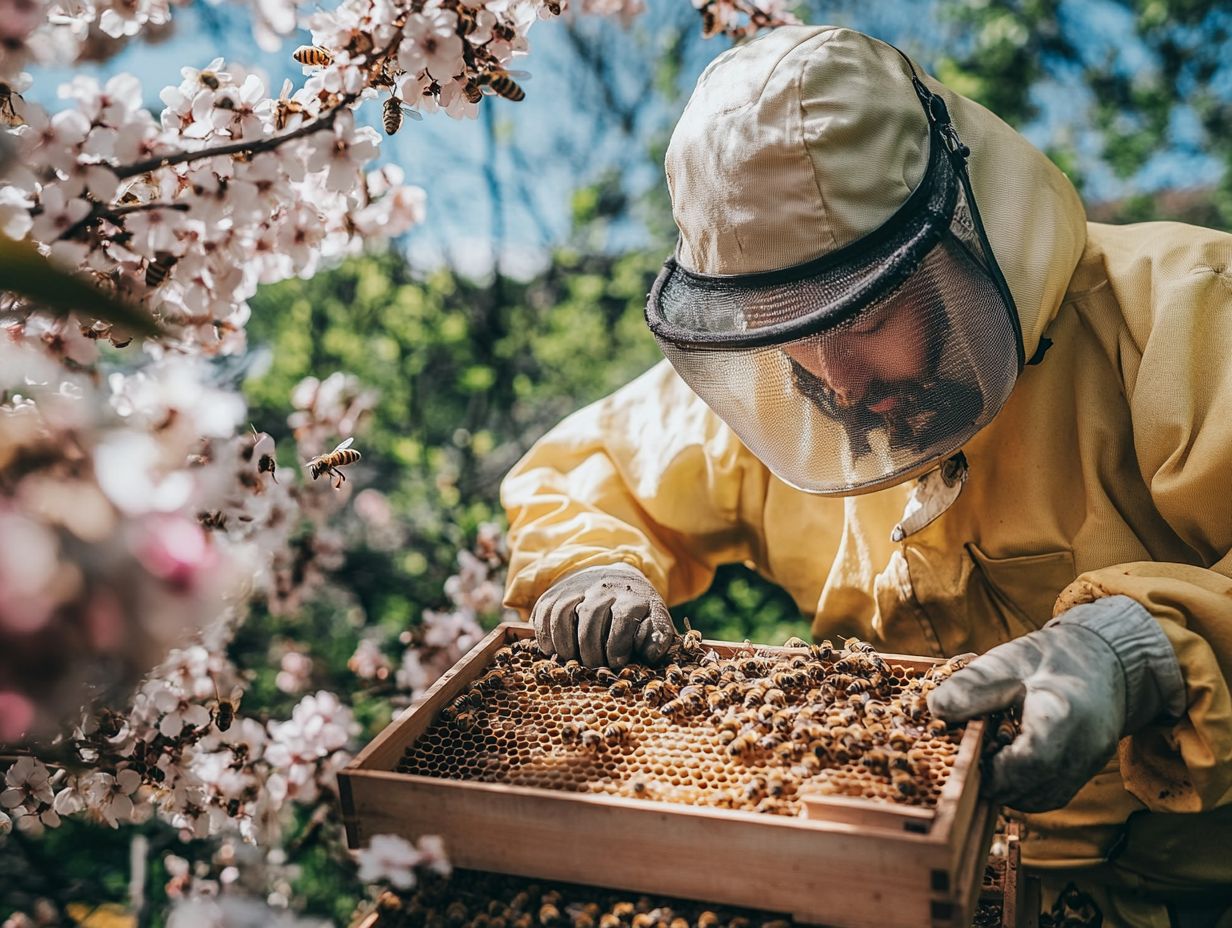
Gathering the necessary equipment is your first crucial step in successfully handling a swarm. As a beekeeper, ensuring you’re well-prepared for the capture process is paramount.
You ll need essential tools, such as a bee suit to protect yourself, a smoker to soothe the bees, and hive tools for managing the hive components safely. Being well-equipped enables you to approach swarm situations with confidence and effectiveness.
Don’t forget to include a swarm net or catch box. This handy addition helps you transport the bees safely once captured. A top-bar or nuc box serves as a temporary haven for the swarm, keeping them secure during transit.
It’s also wise to have a first aid kit ready to address any unexpected stings or minor injuries that may arise along the way. A reliable flashlight will be your best friend when navigating dark corners where swarms may settle, ensuring you miss no detail.
Keep a notebook handy to document the day’s events, including the swarm’s location and any noteworthy observations about their behavior. These insights could prove invaluable for future swarming endeavors!
Thorough preparation with the right equipment enhances not only your safety but also your chances of a successful capture!
2. Locate the Queen Bee
Locating the queen bee during a swarm capture is crucial for ensuring the colony’s future and stability. Successfully finding and securing the queen helps the remaining bees settle into their new hive, promoting overall colony health and cohesion.
By understanding bee behavior and the dynamics of swarming, you can significantly enhance your effectiveness in this essential task. Observing the swarm’s movement provides valuable insights.
Typically, a cluster of bees will gather closely around the queen, forming a dense formation that’s easier to spot. As you navigate the swarm, focus on areas where the bees appear most agitated or where larger clusters are forming; these are often telltale signs of the queen s presence.
Tuning into the sound of the swarm can also be beneficial. A louder buzzing often indicates a higher concentration of bees surrounding the queen. Familiarizing yourself with the queen’s appearance will expedite your identification process, making the capture smoother and more efficient.
3. Move the Swarm to a New Hive
Once you’ve successfully captured the swarm, relocating it to a new hive is the next pivotal step in effective bee management. This transition is vital because it ensures the new hive provides a suitable habitat for the swarm to flourish and helps the bees settle in.
Begin by selecting a location that offers shelter from strong winds while basking in plenty of sunlight. This combination promotes warmth and comfort for your bees. Next, inspect the new hive for cleanliness and structural integrity. This precaution helps prevent potential diseases or pests that could jeopardize the swarm s health.
A well-prepared hive should contain frames with fresh foundation or drawn comb. This setup helps the bees feel at home and encourages them to start building their new colony efficiently. Introducing a sugar syrup as a food source can ease their transition, ensuring that the swarm adapts quickly and can dive into critical activities like foraging and brood rearing, which is raising young bees.
4. Monitor the New Hive
Keep a close eye on the new hive! It’s key to ensuring your bees thrive after relocating the swarm. Regular checks on the brood box and the overall hive conditions allow you to identify potential issues early, whether it s a lack of foraging opportunities or signs of distress.
As you observe the bees settling into their new home, watch for any signs of disease or pests that could endanger the colony’s well-being. Your inspections should focus on the brood pattern, which reveals the queen’s health and productivity. Also, check the stored honey and pollen to ensure adequate resources are available.
Look for signs of swarming. It might indicate overcrowding or environmental stress. By remaining vigilant during these initial stages, you can create a thriving ecosystem that supports the bees and enhances local pollination efforts, leading to a more bountiful harvest.
What to Do if a Swarm Cannot Be Prevented?
Act fast when a swarm appears! Quick management keeps your bees healthy and productive. When a swarm becomes unavoidable, you must act swiftly to manage the situation effectively, ensuring the remaining colony remains viable.
You have several options, including relocating the swarm to a suitable habitat or reaching out to a local beekeeper who can help capture and manage the swarm.
Consider a queen replacement. This can stabilize the remaining colony, promoting healthy hive management practices and ensuring long-term success.
1. Find a New Home for the Swarm
Finding a new home for the swarm is crucial to ensure that the bees can establish themselves and continue their lifecycle. Prepare a new hive with ample resources and space to support colony stability, creating an environment that encourages successful bee relocation.
When setting up, consider vital aspects such as ventilation, available forage, and protection from potential threats. Selecting a location that receives adequate sunlight while also offering shade during the hottest parts of the day is essential.
A well-drained area prevents excess moisture accumulation, which can lead to diseases in the hive. Take into account nearby floral sources to ensure that the bees have access to nectar and pollen, enhancing their ability to thrive post-relocation.
Monitoring the hive for signs of stress or aggression will provide valuable insights into the bees’ adjustment period and ensure that their new environment supports their natural behaviors.
2. Contact a Local Beekeeper
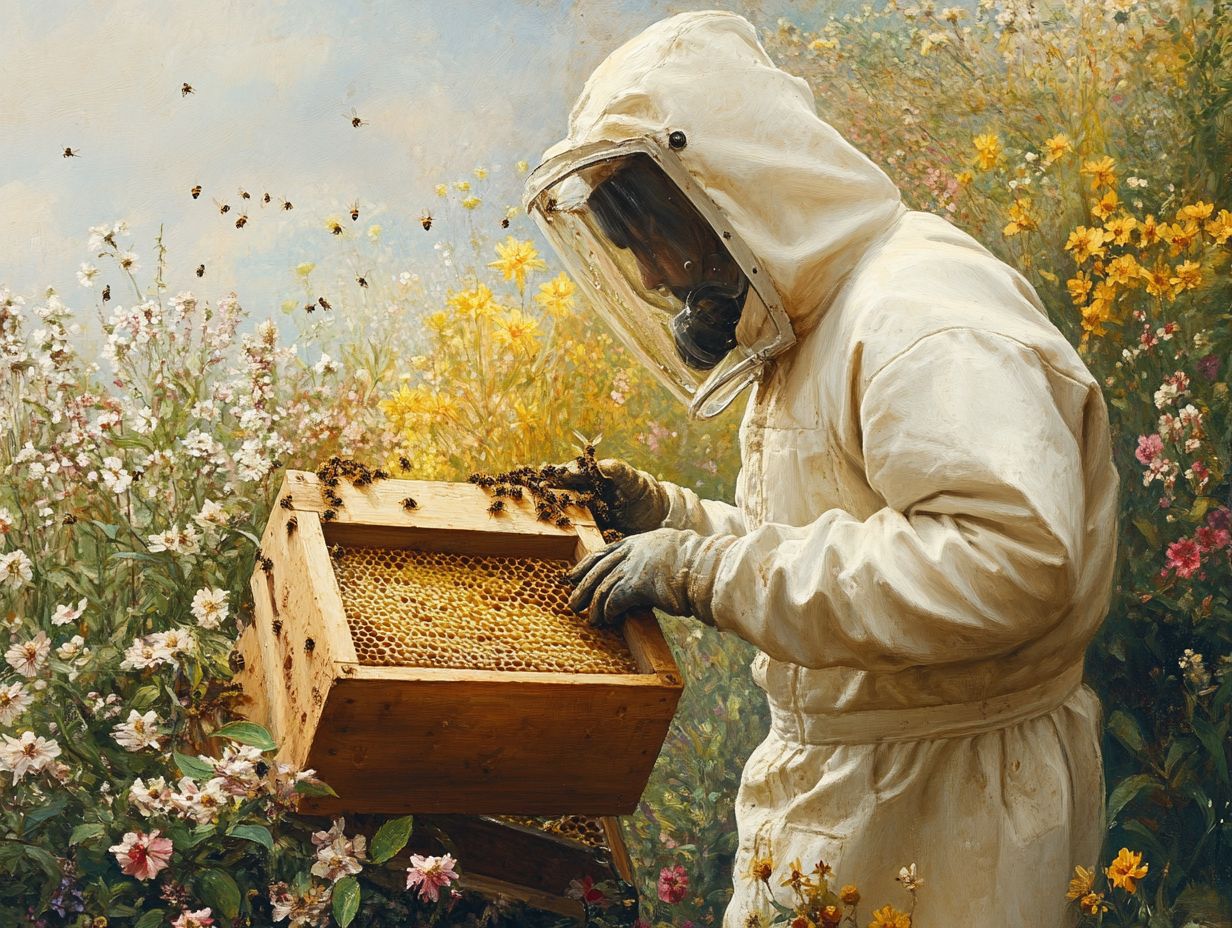
Reaching out to a local beekeeper can be incredibly beneficial when faced with an unexpected swarm. Local beekeepers have the knowledge and tools to help you with swarm capture, swarm traps, or share their wisdom on effective hive management practices, such as brood inspections and spring management. This creates a vibrant community of shared knowledge among beekeeping enthusiasts.
By connecting with these local experts, you not only gain practical insights but also fortify the community ties essential for sustainable beekeeping. Establishing a rapport can pave the way for future collaborations, such as workshops or joint pollination initiatives that enhance local agriculture and reduce swarm tendencies.
Local beekeepers are a treasure trove of information regarding best practices for hive health, disease management, and seasonal tips. This can improve your beekeeping success significantly. They can also provide insights into hive splitting and swarm prevention. Supporting one another within this community allows beekeepers to tackle challenges collaboratively, promote the vital role of pollinators, and advocate for their interests in local environmental policies.
3. Consider Requeening the Hive and Queen Replacement
Considering requeening your hive can be a savvy move in managing the aftermath of a swarm. A new queen can revitalize your colony and make it stronger than ever! By practicing proper queen replacement techniques, such as the Demaree method, you can bolster the resilience of your hive, ensuring it continues to thrive while minimizing the risks linked to swarm dynamics.
By addressing the loss of the original queen, you re reinstating a strong reproductive female capable of laying a consistent brood a vital step in rebuilding your colony’s population. This becomes particularly important after a swarm, as the remaining worker bees may be disoriented and need time to find their footing. Introducing a well-mated queen can also boost genetic diversity, helping to mitigate aggressive behaviors or diseases such as Varroa mites, which are harmful parasites that affect honeybee colonies.
Timing is everything when it comes to requeening, so aim for moments when flowers are plentiful during the nectar flow. This ensures your new brood cycle has ample resources, promoting a more vibrant and sustainable hive environment.
Frequently Asked Questions
What is hive swarming and why is it important to reduce it?
Hive swarming is a natural behavior of honey bees where the queen and a group of workers leave the hive to start a new colony. It is important to reduce hive swarming because it can lead to a decrease in honey production and weaken the overall health of the hive.
How can I identify the signs of a potential hive swarm?
There are several signs to look out for, including a sudden increase in the number of bees in and around the hive, the presence of queen cells, and a decrease in honey production. It is important to regularly inspect your hive to catch these signs early on.
What are some techniques to reduce hive swarming?
One technique is to conduct regular hive inspections and remove any queen cells that are found. Another is to split the hive and create a new colony, giving the bees more space to grow and reducing the likelihood of swarming. Supering early and ensuring good ventilation are also effective strategies.
Ready to take action? Reach out to your local beekeeping association or start your hive management journey today!
Is there a specific time of year when hive swarming is more likely to occur?
Hive swarming usually happens in spring and early summer. This is when the hive is full of bees preparing to gather resources for winter. However, it can also occur at other times based on environmental factors and the hive’s health.
Are there any natural methods to reduce hive swarming?
One natural method is to provide the bees with extra boxes in the hive. This gives them more room to expand and reduces the chance of swarming.
Planting a variety of nutrient-rich flowers and plants around the hive helps keep bees happy and less likely to swarm. A diverse diet is crucial for their well-being.
What should I do if my hive does end up swarming?
If your hive swarms, act quickly! Prevent the bees from settling in a harmful spot by contacting a local beekeeper or a bee removal service.
Make sure the remaining hive has a new queen to keep thriving. Also, track signs of swarming and manage the hive’s population to avoid future swarms.


